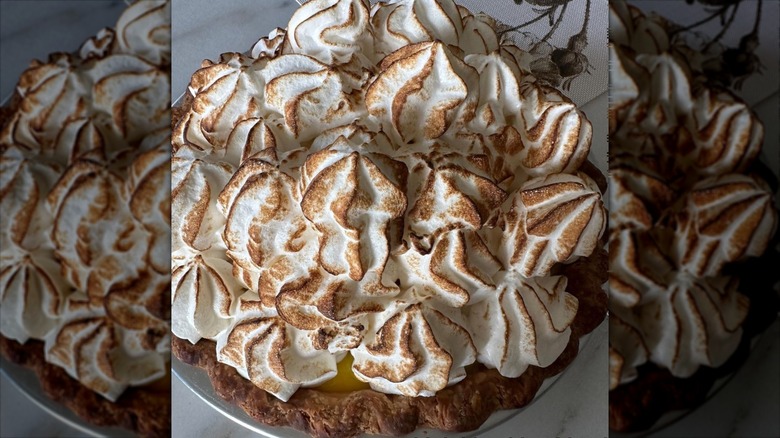Martha Stewart's Sugar Tip To Give Meringue Pies A Crunchy Finish
Select a style of meringue, and start cracking some eggs. Most meringues begin with egg whites that are beaten to soft peaks. Once you get your meringue whipped and fluffy, the next step is all about getting it browned and crispy. This final stage may sound complicated — but it doesn't have to be.
In fact, there are a few easy tricks to perfecting a meringue, whether you're looking to keep your dessert classic or creative. While egg whites are surely the most common base for meringues, you can make a vegan meringue with aquafaba, so long as you add cream of tartar.
Beyond vegan substitutions, meringues leave ample room for interpretation, whether you're playing with ingredients or accompaniments. You can keep things simple with a lemon meringue pie or go European with an Italian meringue made with sugar syrup. No matter your choice, make sure to whip those egg whites in a clean bowl; Lingering moisture can inhibit the whipping stage and prevent your meringue from properly doing its thing.
Once you have your meringue ready, you'll have to add some heat. Luckily, celebrity chef Martha Stewart has some advice for the final torching stage. According to Stewart's Instagram, the key to finishing a meringue is not about the egg whites; Rather, it's all about the sugar.
Use sanding sugar before torching the top of your meringue
A picture says a thousand words and Martha Stewart's Instagram speaks for itself: Stewart posted a photograph of a perfectly golden and crispy meringue to her page. Per Stewart's caption, she made the dessert for lunch guests, layering the meringue over a delicious and refreshing lemon curd. The best part of the post? Stewart's baking advice, which outlined just how you can make her meringue for yourself.
All you need for a Stewart-worthy dessert is a spoonful of sugar. To achieve that perfectly browned exterior, Stewart used sanding sugar, followed by a propane torch. Less common than your standard household white sugar, sanding sugar is a large, crystal sugar perfect for baking (per Bob's Red Mill). It doesn't easily dissolve with heat, so it's especially useful in recipes that require high temperatures like, you guessed it, meringues.
Like Stewart, Food Network recommends sprinkling meringues with sanding sugar prior to adding heat. In their recipe, the meringues are baked rather than torched — but the sentiment still stands: The sugar adds a bit of crunch that can withstand a bit of heat.

